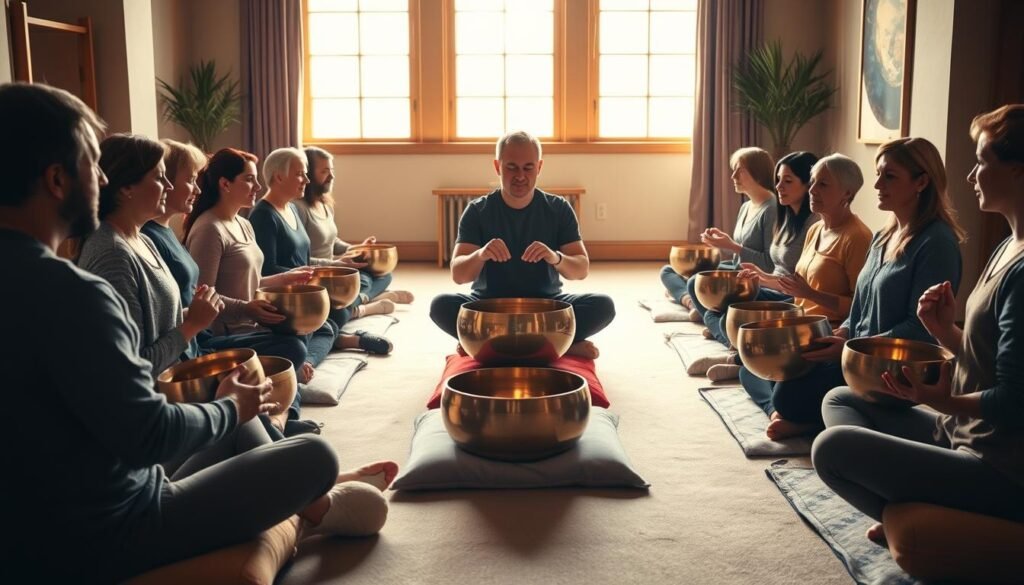
For centuries, singing bowls have been used in meditation and healing. They produce a rich, deep tone. This tone promotes relaxation and calms the mind.
Adding singing bowls to your mindfulness practice can make meditation better. It brings a deeper sense of calm and inner peace.
So, why are singing bowls great for mindfulness and relaxation? They create a soothing atmosphere. This is perfect for meditation and self-reflection.
Key Takeaways
- Singing bowls promote relaxation and calm the mind.
- Incorporating singing bowls into your mindfulness practice enhances meditation.
- Singing bowls create a soothing atmosphere for self-reflection.
- Mindfulness practice with singing bowls fosters inner peace.
- Singing bowls are a powerful tool for sound healing.
Introduction to Singing Bowls
The sounds of singing bowls have won hearts around the world. They offer a special way to relax and meditate. These bowls have a long history in spiritual and healing practices.
Brief History of Singing Bowls
Singing bowls come from the Himalayas, used in ancient spiritual ways. Their history goes back centuries. They were made from metals like tin, copper, and gold, giving them unique sounds and healing powers.
Types of Singing Bowls
There are many types of singing bowls, each with its own features and uses. Here are a few:
- Metal Singing Bowls: Made from metals, these bowls have deep, rich tones. They’re often used in meditation and sound healing.
- Crystal Singing Bowls: Made from quartz crystal, these bowls have a clear, bell-like sound. They’re thought to deeply affect the body’s energy centers.
Benefits of Using Singing Bowls
Using singing bowls for meditation and relaxation brings many benefits. Their sound can lower stress, bring calm, and improve meditation. The bowls’ vibrations are thought to align the brain’s hemispheres, leading to deep relaxation and peace.
The healing powers of singing bowls are also significant. They help balance the body’s energy, or chakras. Regular use can improve mental clarity, reduce anxiety, and bring deeper relaxation.
The Science of Sound and Mindfulness
Exploring the science of sound and mindfulness shows how singing bowls’ vibrations impact our minds. Sound therapy, like singing bowls, improves both our mental and physical health.

Sound healing uses the brain’s response to sound frequencies. When we hear singing bowls’ tones, our brain processes them in a special way. Studies show that certain sounds can change brainwaves, helping us relax or meditate.
How Sound Affects the Brain
The brain changes its activity when it hears sound. Lower frequency sounds, like singing bowls, slow down brainwaves. This leads to calmness and less stress.
When we hear singing bowls, our brain starts to match the sound’s frequency. This is called entrainment. It helps our brain find balance and well-being.
The Role of Vibrations in Relaxation
Singing bowls’ vibrations are key to relaxation. As the bowl is played, the vibrations reach our body. They make us feel calm and reduce muscle tension.
Using singing bowls for sound therapy can help manage stress and promote relaxation. By understanding how sound affects us, we can see the value of singing bowls in mindfulness.
Choosing the Right Singing Bowl
Finding the right singing bowl can seem hard. But knowing about the different types and their features helps a lot. It’s important to know what to look for to find the perfect bowl for you.
Material and Size Considerations
Singing bowls come in various materials like bronze, brass, crystal, and metal alloys. Each material has its own sound and characteristics. For instance, bronze bowls have warm tones, while crystal bowls sound like bells.
The bowl’s size also matters. Bigger bowls make deeper sounds, and smaller ones make higher sounds. Think about the space and sound you want when picking a bowl.
| Material | Sound Characteristics | Size Considerations |
|---|---|---|
| Bronze | Rich, warm tones | Medium to large sizes |
| Brass | Bright, clear tones | Small to medium sizes |
| Crystal | Clear, bell-like sound | Various sizes available |
How to Select for Your Purpose
Think about how you’ll use the bowl. For meditation, a calming sound is best. For healing, a more vibrant sound might be better.
When picking a singing bowl, consider:
- The sound quality and tone
- The material and craftsmanship
- The size and portability
- The aesthetic appeal

By thinking about these points and knowing about different bowls, you can find the perfect one. It will help you in your mindfulness practice and bring balance to your life.
Preparing Your Space for Mindfulness
A clean and calm space makes your mindfulness with singing bowls better. The place where you practice mindfulness is key to relaxing and focusing well.
Creating a Tranquil Environment
Think about the lighting in your space. Soft, natural light or dimmable lamps can create a peaceful mood. Candles or fairy lights add warmth and make the space welcoming.
Choosing the right seat is also important. Find a quiet, comfy spot for sitting. A meditation cushion or chair can help you relax.

Recommended Items for Your Practice
Some items can make your singing bowl practice better. Consider adding:
- Incense or Essential Oils: Scents like lavender or sandalwood can help you relax and reduce stress.
- Meditation Cushions or Chairs: Comfortable seating keeps you in a relaxed position during practice.
- Candles or Soft Lighting: Gentle light makes the atmosphere calm, helping you focus on mindfulness.
- Plants: Adding plants brings tranquility and connects you to nature.
Preparing your space well supports your mindfulness practice. It helps you get the most from singing bowls.
How to Use a Singing Bowl: Step-by-Step
Learning to use a singing bowl can enrich your mindfulness and relaxation. Just a few simple steps can unlock its full potential. This can greatly improve your meditation.
Positioning the Bowl
To begin, place your singing bowl correctly. Hold it in your hand or on a cushion, making sure it’s steady. This is key for a clear sound. Try different positions to find what works for you.

Striking and Rimming Techniques
To make sound, strike or rim the bowl softly. Use a mallet made for singing bowls. Start by hitting the side gently to start the sound. For a continuous sound, move the mallet around the rim in a clockwise direction with soft, steady pressure. Practice makes perfect, so keep trying until you get it right.
Incorporating Your Breath
Linking your breath with the bowl’s sound can deepen your relaxation and mindfulness. As you listen, breathe in sync with the bowl’s vibrations. Take slow, deep breaths, inhaling as the sound grows and exhaling as it wanes. This can make your meditation more effective and calming.
By following these steps and practicing often, you can make singing bowls a part of your mindfulness routine. Remember, patience and enjoyment are key.
Incorporating Singing Bowls into Meditation
Adding singing bowls to your meditation can make it more immersive. These bowls have been used for centuries to deepen meditation. They help promote relaxation and improve focus.
Guided Meditation Techniques
Guided meditation with singing bowls uses sound to keep your focus. Start by gently striking the bowl and then circling the rim. This creates a continuous sound. As you meditate, focus on the vibrations and let go of distracting thoughts.
Begin with a short guided meditation:
- Sit comfortably with your back straight.
- Strike the singing bowl and let the sound fill the space.
- Close your eyes and focus on your breath.
- As you inhale, imagine fresh energy entering; as you exhale, imagine tension leaving.
Enhancing Your Practice with Sound
The sound of singing bowls can greatly enhance your meditation. The vibrations from the bowls calm the mind, reduce stress, and promote well-being.
| Benefit | Description |
|---|---|
| Reduced Stress | The calming vibrations help reduce stress and anxiety. |
| Improved Focus | The sound of the bowls can improve concentration and mental clarity. |
| Enhanced Relaxation | The resonant tones promote deep relaxation and calmness. |
Tips for Effective Use:
To get the most out of your singing bowl meditation, find a quiet, comfortable space. Try different striking and rimming techniques to find what works best for you.

By adding singing bowls to your meditation, you can have a more profound experience. Regular practice can lead to greater mindfulness, reduced stress, and a sense of well-being.
Using Singing Bowls for Stress Relief
The soothing sounds of singing bowls can help fight daily stress and anxiety. Adding singing bowls to your daily routine can bring peace to your busy life.

Short Practices for Busy Days
Even a few minutes of mindfulness can change your day. Here are quick practices for busy days:
- One-Minute Breathing Exercise: Hold the singing bowl in your lap, breathe in deeply, and strike it gently. As you breathe out, ring the bowl to keep the sound going, focusing on your breath.
- Three-Minute Mindful Listening: Place the singing bowl on a cushion or your palm, strike it softly, and listen closely to the sound. Let go of any thoughts that distract you.
Using Singing Bowls Before Sleep
Singing bowls can also help you sleep better. Their calming vibrations and sounds tell your body it’s time to relax.
| Practice | Duration | Benefits |
|---|---|---|
| Gentle Rimming | 5 minutes | Relaxes the mind and body |
| Soft Striking | 3 minutes | Calms the nervous system |
| Focused Listening | 2 minutes | Quiets the mind |
By adding these simple practices to your day, you can use singing bowls to reduce stress and boost your well-being.
Singing Bowls in Group Settings
Group sound healing with singing bowls is a special way to relax together. It’s become popular for bringing people together. This practice helps everyone feel more connected and well.

Benefits of Group Sound Healing
Group sound healing with singing bowls offers many benefits. It helps people relax better, feel more connected, and think clearer. When we come together for sound healing, we share a powerful energy. This energy makes the healing stronger.
- Reduces stress and anxiety
- Promotes a sense of calm and well-being
- Enhances the sense of community and connection among participants
How to Facilitate a Group Experience
To host a group sound healing, you need to plan and prepare. Here’s what to do:
- Find a quiet, comfy spot for everyone to meet.
- Pick different singing bowls for a wide range of sounds.
- Start with a quick intro to the practice and its benefits.
- Lead the group through sound healing exercises with the singing bowls.
- Tell everyone to breathe deeply and relax.
| Tips for Facilitating Group Sound Healing | Benefits |
|---|---|
| Create a peaceful atmosphere | Enhances relaxation and reduces stress |
| Use a variety of singing bowls | Creates a diverse and engaging sound experience |
| Encourage deep breathing | Promotes relaxation and reduces anxiety |
By following these steps and tips, you can host a group sound healing that’s both meaningful and beneficial. It will help everyone relax, feel more connected, and improve their overall well-being.
Exploring Different Playing Techniques
To get the most out of your singing bowl, it’s essential to explore various playing techniques. The way you play your bowl can significantly affect the sound produced and the overall experience.
Basic Techniques for Beginners
For those new to singing bowls, starting with the basics is crucial. Hold the bowl gently but firmly in the palm of your hand or on a cushion, depending on the size and your preference. The most common method for producing sound is by using a mallet.
- Striking the Bowl: Gently strike the side of the bowl to produce an initial sound.
- Rimming the Bowl: Run the mallet around the outer rim to sustain the sound. Apply gentle to moderate pressure, depending on the desired volume.
Experimenting with different striking and rimming techniques can help you discover the full range of tones your bowl is capable of producing.

Advanced Play for Experienced Users
For those who have mastered the basics, there are several advanced techniques to further enhance your practice. Experimenting with different mallets can produce a variety of tones and dynamics. Some players also enjoy incorporating circular motions with the mallet around the bowl’s rim for a continuous sound.
| Technique | Description | Effect |
|---|---|---|
| Slow Rimming | Slow, gentle motion around the rim | Produces a deep, resonant sound |
| Fast Rimming | Quick motion around the rim | Creates a brighter, more vibrant sound |
| Striking and Rimming Combination | Alternating between striking and rimming | Offers a dynamic range of sounds and effects |
By exploring these advanced techniques, you can tailor your singing bowl practice to suit your meditation or relaxation needs, enhancing the overall experience.
Combining Singing Bowls with Other Practices
Using singing bowls with yoga or aromatherapy can lead to deep relaxation. These practices together can make you feel more relaxed and well. It’s a great way to improve your overall well-being.
Yoga and Singing Bowls
Adding singing bowls to your yoga can make it even better. The bowls’ sounds help match your breath and movements. This makes your yoga more meditative.
To add singing bowls to your yoga:
- Start with a goal for your practice and sound the bowl to begin.
- Let the bowl’s sound help you relax during savasana or between poses.
- End with the bowl’s sound to keep the calm and peace.
Aromatherapy and Sound Healing
Aromatherapy and singing bowls together can make your mindfulness practice even richer. Essential oils can boost the emotional and mental effects of the sound. Here’s how to mix them:
- Use a calming essential oil like lavender during your sound healing to relax.
- Put a few drops of grounding oil like cedarwood on your pulse points before starting.
- Try different scents to see what makes your sound healing better.
By mixing these practices, you get a full experience for body and mind. Try different mixes to see what works best for you. Feel free to change things as you find what brings you peace and calm.
Common Mistakes to Avoid
To get the most out of your singing bowl practice, it’s crucial to be aware of common mistakes. These mistakes can hinder your mindfulness and relaxation experience. Knowing them can help you improve your practice.
Misconceptions About Singing Bowls
Many think singing bowls are only for meditation or for experienced users. But, singing bowls can help anyone reduce stress and improve mental health. They are versatile and can be used in yoga and aromatherapy too.
Another mistake is focusing only on sound quality when choosing a bowl. While sound is key, size, material, and look also matter for your practice.

Tips for Effective Use
To use singing bowls well, pick one that feels right to you. Think about size, material, and sound. A bowl that’s too big or small might not feel right.
Here are some tips for using singing bowls effectively:
- Start with a regular practice schedule to get better.
- Try different ways of striking and rimming to find what works for you.
- Use your singing bowl with other mindfulness practices like deep breathing or meditation.
| Common Mistake | Correction | Benefit |
|---|---|---|
| Not choosing the right size bowl | Select a bowl that is comfortable to hold and play. | Enhanced sound quality and ease of use. |
| Incorrect striking technique | Experiment with different mallets and striking methods. | Improved sound clarity and resonance. |
| Not incorporating breathwork | Combine singing bowl use with deep breathing exercises. | Increased relaxation and mindfulness. |
By knowing these common mistakes and following these tips, you can make your singing bowl practice better. Enjoy a more fulfilling mindfulness and relaxation experience.
Conclusion: Finding Your Rhythm with Singing Bowls
Singing bowls can be a great tool on your mindfulness journey. By using the tips from this article, you can make your relaxation and meditation better.
Deepening Your Practice
Try different singing bowls and techniques to see what works for you. You’ll find how singing bowls can help you stay focused and present.
Continuing Your Journey
Adding singing bowls to yoga or aromatherapy can make your practice even better. This mix can lead to a more balanced life. Keep using singing bowls and stay open to new ways to include them in your day.
Using singing bowls is a big step towards finding peace within. Keep exploring and enjoying your mindfulness journey with singing bowls.
